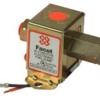Just when you thought you'd heard just about everything on Pearl's heater, along come something new. And what's that?
Jealousy, pure and simple. But we'll get to that.
The way my heater works is I turn it on and then set the desired cockpit temperature using a digital thermostat, just like you probably have at home. The heater itself puts out a constant amount of heat, just like your home furnace (in fact, it is identical to a miniature home oil burner, nothing more) but I throttled mine back by leaning out the fuel to make it run cooler because I was afraid of getting it too hot. After all, it was the first gas heater I had seen and I really didn't now what to expect. Playing with it on the bench I could get an output temp of over 300ºF but I set it up to output about 180ºF, just like my Nissan Rogue. That worked, but it wasn't overwhelming so I added something to bring it up to about 200ºF with a switch to toggle between the two output temps.
THAT all works well, but under 40ºF outside and with all of the air leaks in a Speedster, the 200ºF output is a little lacking and I kept thinking, "Wouldn't it be nice to be able to dial the temp I want just by turning a knob on the dash like my daily driver?
That's where the jealousy part came in - That's exactly how the gas heaters in Danny P. and Jack Crosby's car work - You turn it on, then dial in the amount of heat you want coming out. When it gets too hot, just turn it down a little. Too cool? Turn up the heat. Pretty simple.
My heater (a very low-tech version, to be sure) has a solenoid fuel pump that squirts a set amount of fuel for each stroke and it is driven by a little circuit that Danny P. made that produces a set number of pulses to the pump per minute. You get more heat by running the pump faster within a range. 150 pulses per minute gives about 170ºF. 300 pulses per minute gives about 310ºF. Pretty simple, but I needed a variable speed circuit as a driver for the pump and after a ten minute search on Amazon and next day delivery, I received this little gem (I show the USB thumb drive as a size comparison):
This is a pretty cool circuit that has nifty adjustments to fine-tune what you need. It is tiny, as you can see, fully assembled and cost me all of $12 bucks, delivered the next day.
$12 BUCKS!
I haven't begun playing with it yet, as I'm waiting for one more part (the MOSFET on the output side, Dan) and then I can start playing with it. I suspect that I'll end up playing with component values on the circuit board to custom-tailor the pulse range to the 150 - 300-ish that I want, but that'll be the fun part. Even more fun is that I may need some suggestions from the peanut gallery on component values once I get into this if I have to change things, so stay tuned and heads up @DannyP and @Michael Pickett
The idea is that this could replace the digital thermostat under my dash with a small box (size of a pack of cigarettes) with the on/of switch for the heater and a heat level knob for the fuel pump. Simple and unobtrusive.
Can you tell that I'm getting a little bored from COVID and need something to do?
So far, there are three heaters working like mine (that I know of) - Mine, Cory Drake's (Danny's old heater) and Tyler in Seattle using the same circuit and pump as me in his VW Beetle (he saw my thread on the Samba and contacted me about it). Mine is throttled way back, while Tyler's (Seattle) and Cory's, running faster, put out GOBS of heat, which they like. Mostly, I'm doing this to mine so as NOT to be jealous of Jack and Danny any more. And for something to do for a couple of days before cold weather hits. And a way to have a more comfortable cockpit with all of the air leaks that Speedsters have.
Here we go again!




